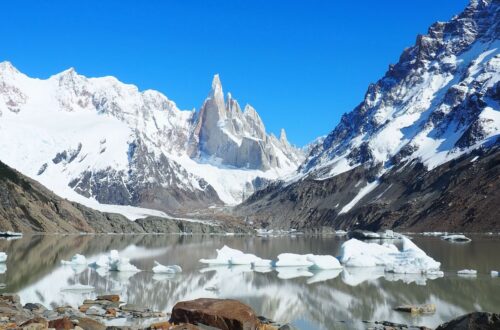An Expat’s Ultimate 3-Day Buenos Aires Itinerary for First-Timers
Buenos Aires is a fascinating city that feels both South American and European. No wonder the city is normally referred to as the Paris of South America.
Buenos Aires features French-inspired architecture and Italian food. As the cherry on top, this cultural melting pot is also the home of tango.
You can easily spend a couple of days, weeks… or even months in Argentina’s capital! Just look at me; I ended up staying in Buenos Aires for 7 years!
However, if you are short on time and want to be sure that you add the most important sights to your Buenos Aires itinerary, then this post is for you!
If you are traveling to Buenos Aires and Argentina for the first time, I recommend that you also take a look at my best travel tips for first-timers in Buenos Aires!
In this post, I give you a complete guide on how to spend 3 days in Buenos Aires including a map and descriptions on how to get from one place to another.
If you are planning to stay longer than 3 days in Buenos Aires, check out my other Buenos Aires resources:
- Hidden Gems in Buenos Aires
- Free things to do in Buenos Aires
- Beautiful viewpoints in Buenos Aires
- Amazing architecture in Buenos Aires
- World-class street art in Buenos Aires.
- The most popular day trips and getaways from Buenos Aires
3 Days in Buenos Aires: The Top 20 Things to Do & See (+ 10 Bonus Sights)
Disclosure: Some of the links below are affiliate links. This means that at no additional cost to you, Becci Abroad will earn a commission if you purchase through one of those links. This helps to pay the bills and the maintenance of the site.
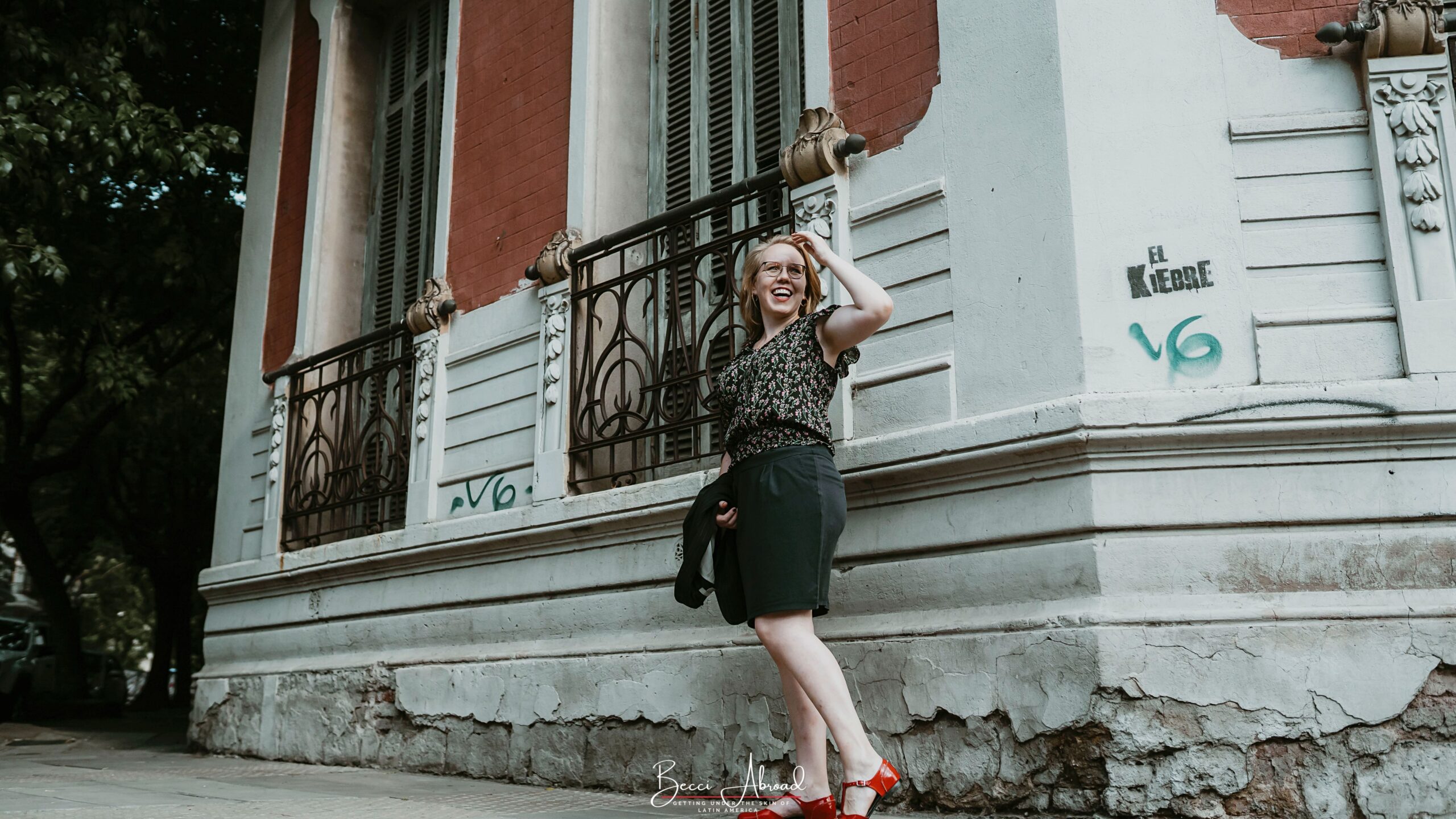
Explore the map below with 20 of the most classic tourist places to visit in Buenos Aires and how to fit them into a 3-day itinerary.
The yellow spots are 10 additional points of interest mentioned in the descriptions below. Check them out in case you have time and want to explore some more!
Below you find the descriptions of each of the places and how to get from one place to another. If you prefer exploring the city with a guide, then there are also several private tours and group tours of Buenos Aires.
Day 1: Downtown Buenos Aires
Spend your first day in Buenos Aires exploring the historical center of the city with many important landmarks. These are places you don’t want to miss!
All of these places can be reached by foot. You can follow the directions on the map and in the descriptions below.
#1 Casa Rosada
A visit to Buenos Aires isn’t completed without a visit to Casa Rosada, also known as the presidential Pink House!
The Pink House is the executive office of the Argentine president. It’s located at the square, Plaza de Mayo, downtown.
The Pink House has been the center of many historical events in Argentina. One of the most famous scenes is properly the former First Lady, Evita Perón (Eva Maria Duarte Perón), talking to a huge crowd at Plaza de Mayo from the balcony of the Pink House. If you do haven’t seen the recording of the real thing, you have properly seen Madonna’s impersonation of Eva Perón in Don’t Cry for Me Argentina.
During the week, the Pink House is closed to the public. But you can always drop by for a quick photo of the Pink House from the outside.
You can visit the Museum for the Pink House from 11 am to 6 pm Wednesday through Sunday. The entrance is free of charge.



#2 Plaza de Mayo
Plaza de Mayo, translated as the May Square, is a historically important square right in the center of Buenos Aires. Apart from the famous Pink House, the May Square also houses Buenos Aires’ Cathedral, the old Spanish imperial town hall, el Cabildo, and the Argentine National Bank.
During the Argentine Dirty War in the 1970s, May Square became internationally known. During this time, the association of the Mothers of the May Square (in Spanish Madres de Plaza de Mayo) silently demonstrated on the square against the illegal disappearances of their children and grandchildren.
The square is located in the neighborhood of Montserrat. On the one side, you have the area popularly referred to as Microcentro porteño or downtown Buenos Aires.
On the other side, you have the historical neighborhood of San Telmo. Here you will find old colonial houses, cobblestone streets, and on Sundays the popular San Telmo Sunday Market.
Behind the Pink House, you have the exclusive Puerto Madero neighborhood. And on the opposite side of the square, the historical Avenida de Mayo.
Check out this city tour from Viator that includes Plaza de Mayo, Puerto Madero, la Boca, and Recoleta Cemetery.
Bonus Sight 1: For a great view and photo over the May Square, visit the town hall museum, Museo Histórico Nacional del Cabildo y la Revolución de Mayo.
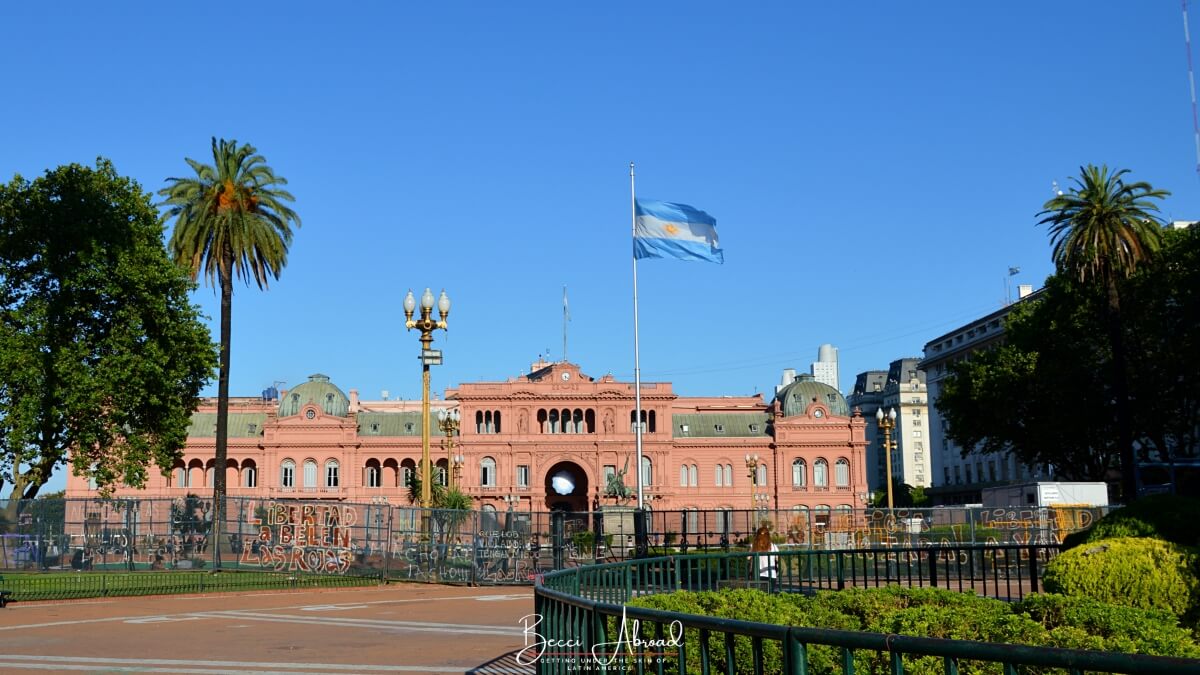
#3 Buenos Aires Cathedral
The Buenos Aires Cathedral, or Catedral Metropolitana de Buenos Aires, is the main cathedral for the city of Buenos Aires.
The cathedral is located at the May Square. If you are in doubt about which of the many beautiful old buildings it is, then look for the one that looks like an old Greek temple.
Inside the cathedral, you can find the grave of Argentina’s national hero, José de San Martin. He was one of the most important independence fighters in the Argentine independence fight against the Spanish Empire. San Martin also took part in liberating Chile and Peru.
The entrance to the cathedral is free.
Get more ideas for free things to do in Buenos Aires!


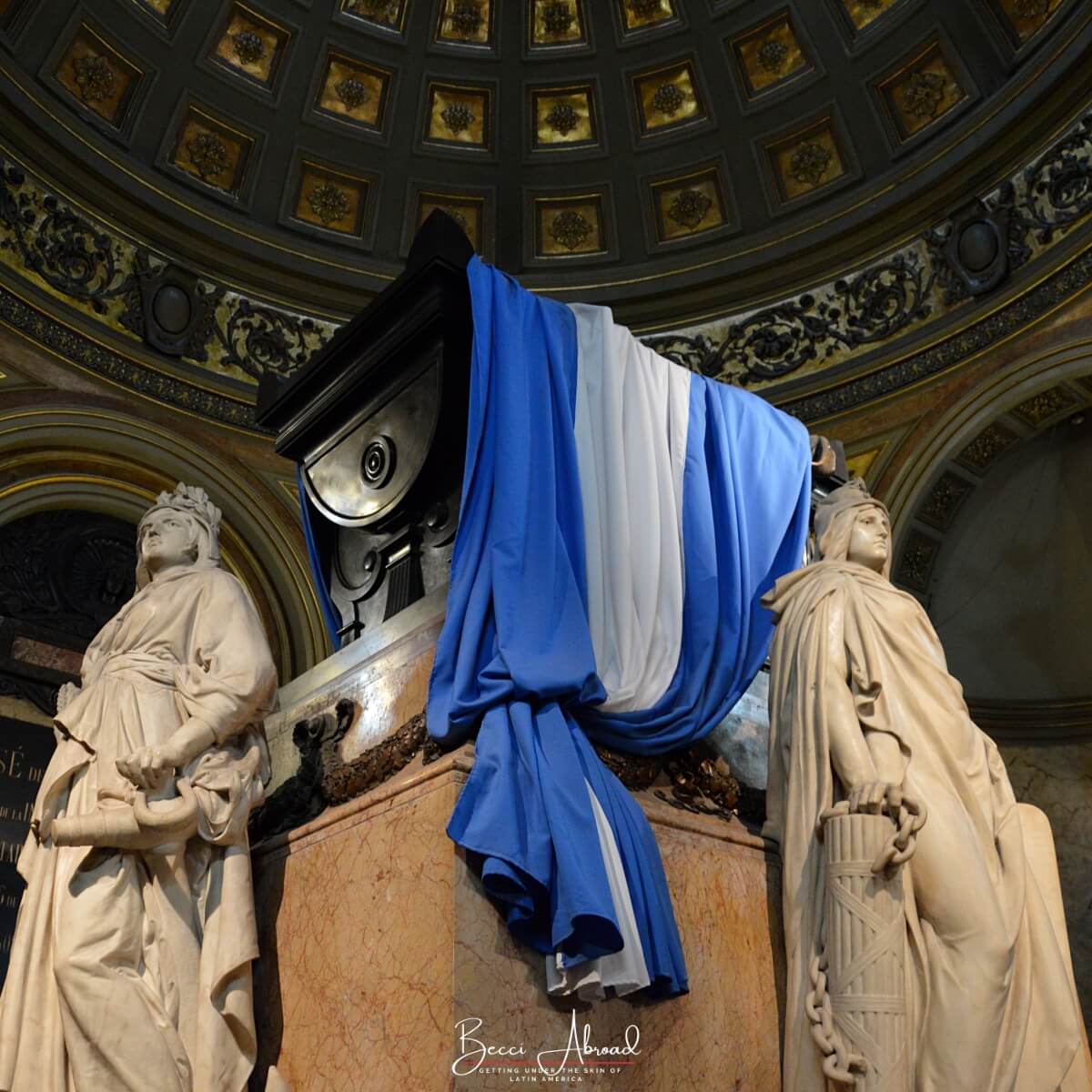
#4 Puerto Madero
Puerto Madero is a modernized and exclusive area of the city. Many international companies and high-end restaurants are located here.
The restaurants in Puerto Madero tend to be pretty pricey. However, at lunchtime, you can be lucky to find cheaper menu options, called menú del día.
In 1882, Puerto Madero was built as a part of the harbor of Buenos Aires. However, over time the low waters of the area made it obsolete due to the advancement of the ships. Today, you can still see the old red brick buildings that used to be packhouses. Some years ago, an effort was made to modernize the area. The old red buildings were left but they were completely renovated and modernized.
Puerto Madero is one of the only places where you get reminded that Buenos Aires is located by the river.
Signing up for a bike tour of Buenos Aires is a great way to explore more of the city in a short amount of time – and it includes visiting both Puerto Madero and Reserva Ecológica!
Bonus sight 2: If you continue walking past Puerto Madero with the Pink House behind you, you will come to the entrance of Buenos Aires’ largest green space, the natural reserve Reserva Ecológica Costanera Sur. From here you can get to the banks of the river, Río de la Plata.
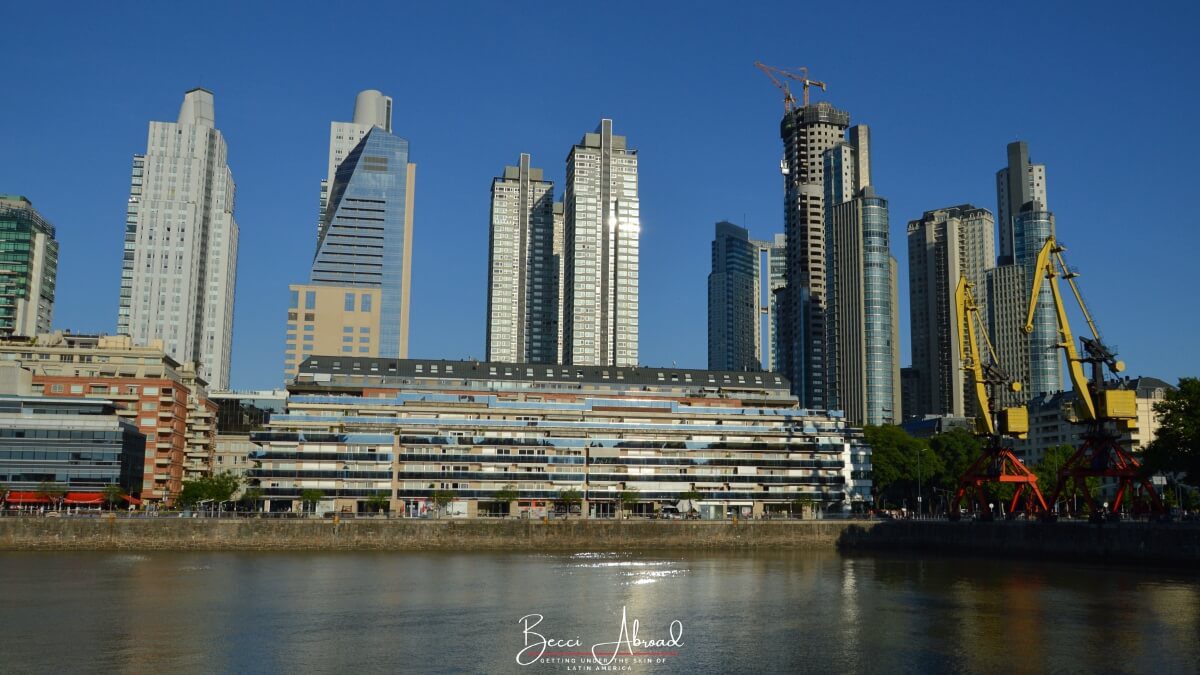
#5 Puente de la Mujer
In the middle of Puerto Madero, you will find Puente de la Mujer, the woman’s bridge. The bridge is a modern piece of architecture and has become an important landmark for Buenos Aires.
The architect’s inspiration for the bridge and its name was a woman dancing a tango. When the bridge opens for ships passing by, it should look like a woman swinging her legs in a tango… Well, up to you what you think of that when you see the bridge.
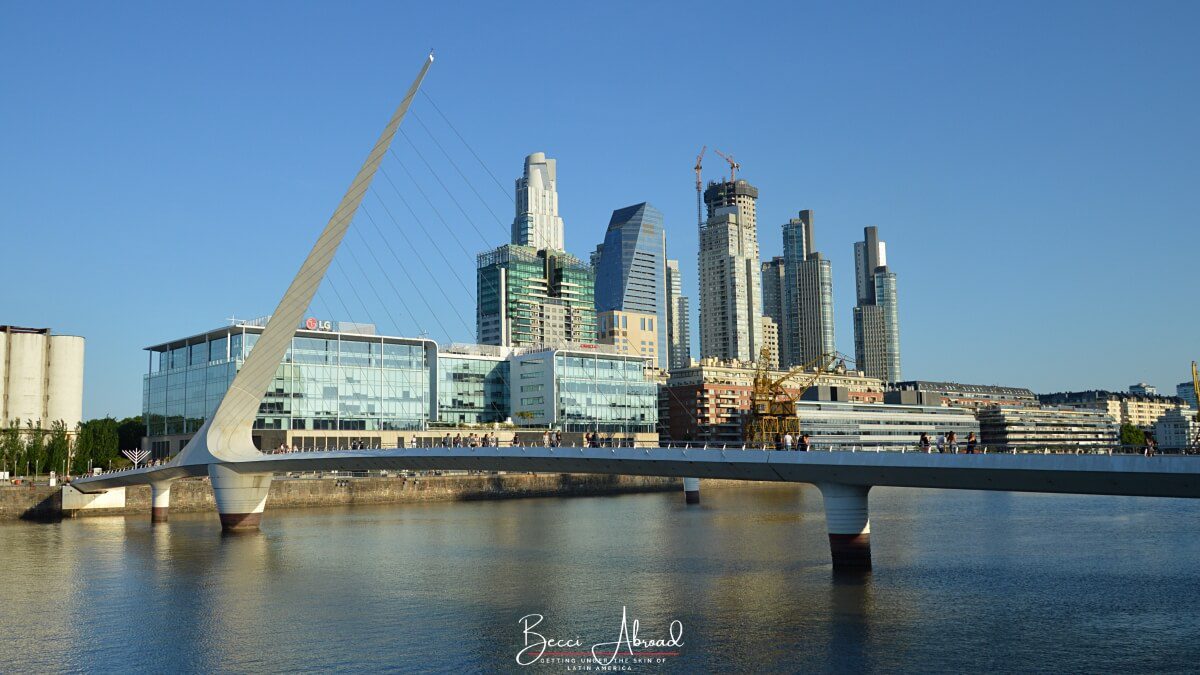
#6 Avenida de Mayo
Avenida de Mayo or the May Avenue is a historic avenue in the center of Buenos Aires. This wide avenue leads from the May Square towards the famous landmark, the Obelisk, and further on the National Congress of Argentina.
Walk back to Plaza de Mayo from Puerto Madero. When you stand with the Pink House behind you, and in the right-hand corner, you will see Avenida de Mayo.
A walk down Avenida de Mayo is truly a walk down memory lane of Buenos Aires’ past. On the avenue, you will come by traditional Buenos Aires coffee shops and beautiful old buildings such as the Barolo Palace.
Bonus Sight 3: Stop at Café Tortoni, one of the most popular and well-reserved traditional coffee shops on Avenida de Mayo.
Bonus Sight 4: If you want to experience Avenida de Mayo from above, I recommend reserving a table at the Dome Rooftop Bar at Hotel Tango de Mayo, one of the best viewpoints in Buenos Aires.

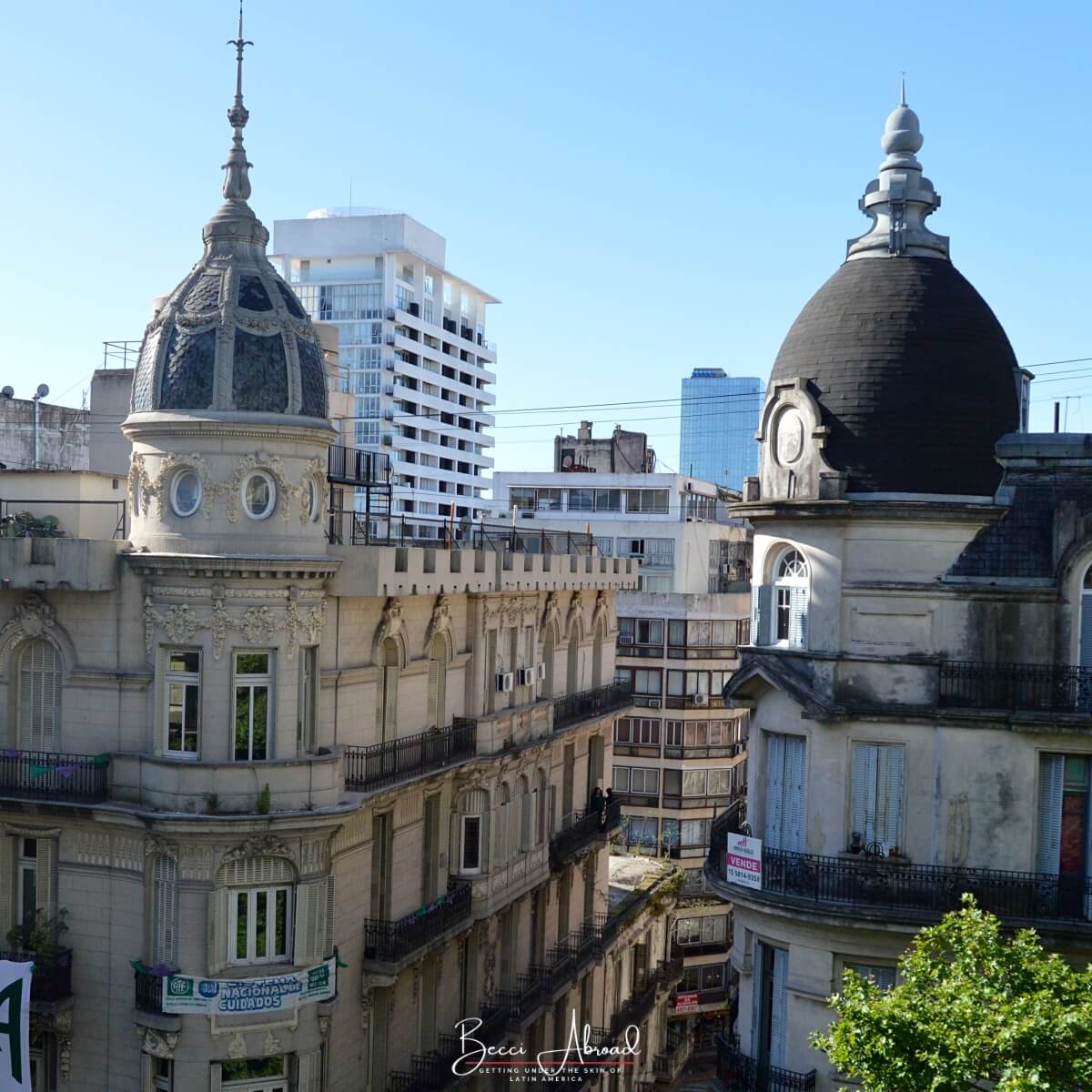
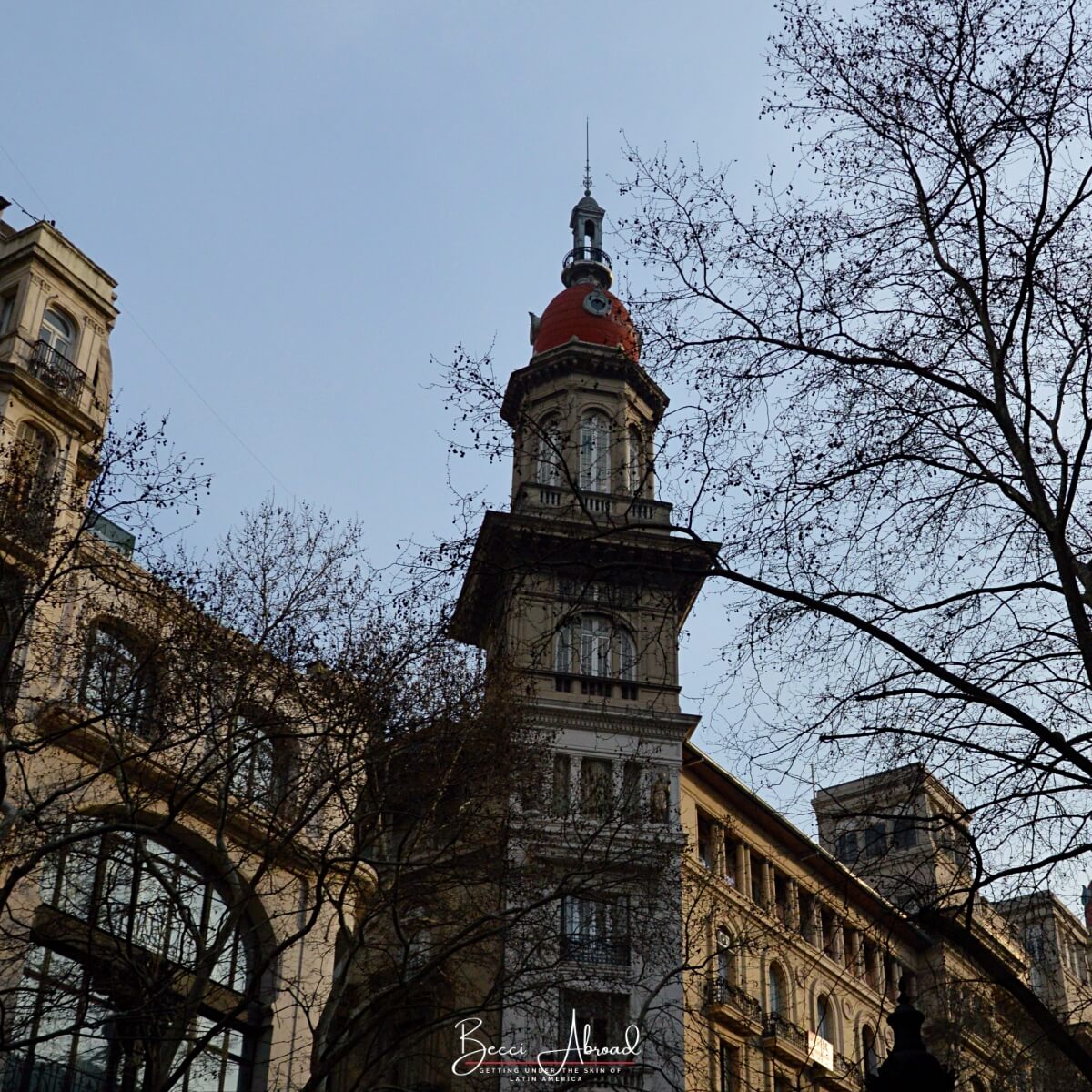
#7 Avenida 9 de Julio
Avenida 9 de julio or translated as Avenue 9th of July, is the most iconic avenue in Buenos Aires. It is said to be the widest avenue in the world.
On your way down Avenida de Mayo, you will cross Avenida 9 de Julio. Stand still for a second and observe the traffic. The aggressive drivers hammering their horns, and buses in all the colors of the rainbow passing fast by your side. Life is hectic at 9 de Julio!
On Avenida 9 de Julio, you will find another iconic building in Buenos Aires; the Ministry of Public Health.
This building is famous for its huge Evita Perón-silhouette on either side of it. One pretty-looking version of her and another aggressively speaking into a microphone. It is said that the nice-looking is watching the rich oligarchic Northern neighborhoods. While the other is turning South and speaking to empower the working class to protest.
Bonus Sight 5: Walk past the Ministry of Public Health’s enormous building to get a look on both sides of the Evita Perón-silhouette.


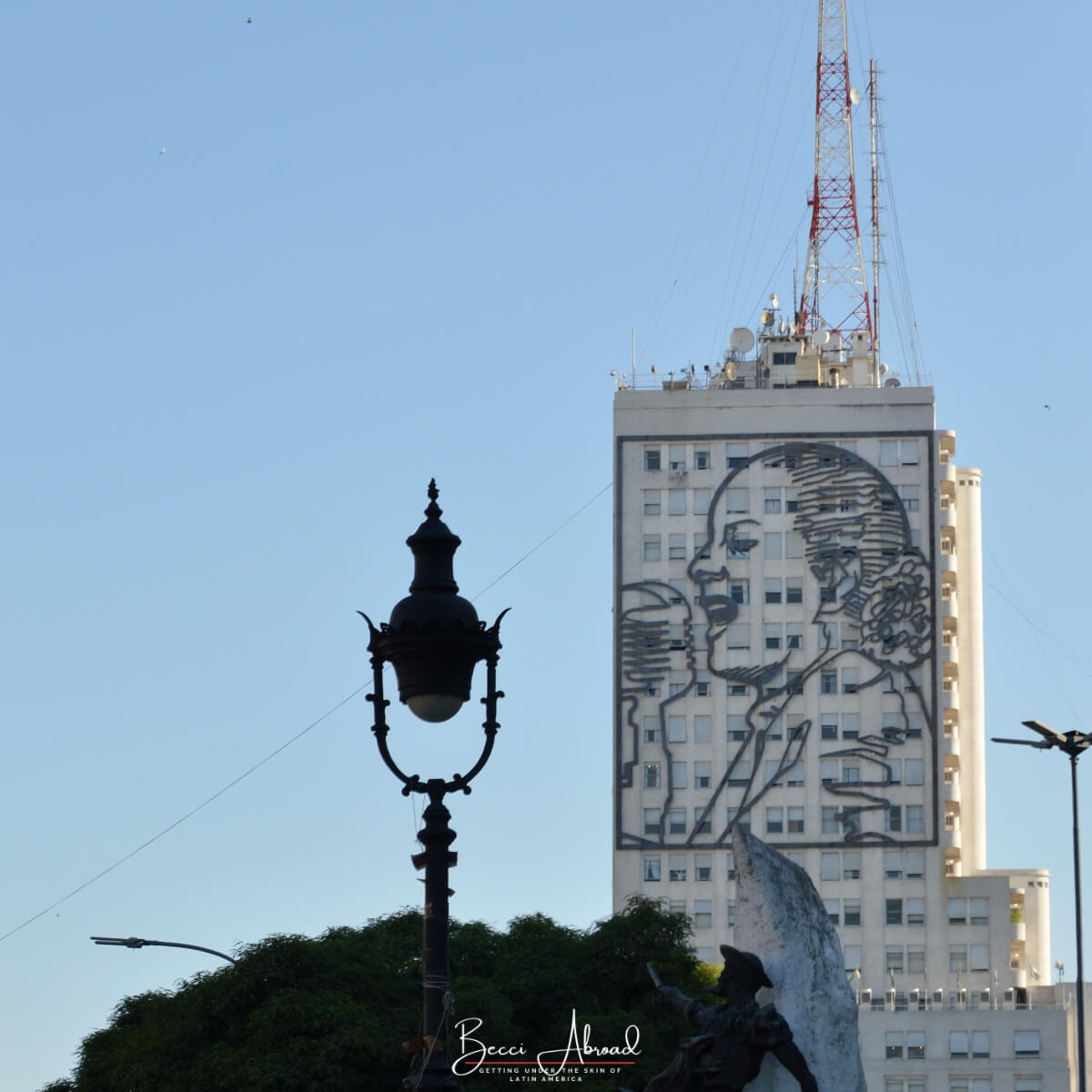
#8 El Obelisco
While standing on 9 de Julio, take a look to your right. There you have another landmark of Buenos Aires; el Obelisco.
The Obelisk was inaugurated in 1936 in honor of the foundation of Buenos Aires, and it is located where the Argentine flag rose for the first time in the City of Buenos Aires.
It stands at the intersection of Avenida 9 de Julio and Avenida Corrientes, two of the most important avenues in Buenos Aires. Avenida Corrientes is known for being Buenos Aires’ version of Broadway with theaters located side-by-side.
Bonus Sight 6: Stop at Pizzería Güerrín on Avenida Corrientes for a traditional Argentine pizza experience. The pizza place is one of the most popular places among locales.


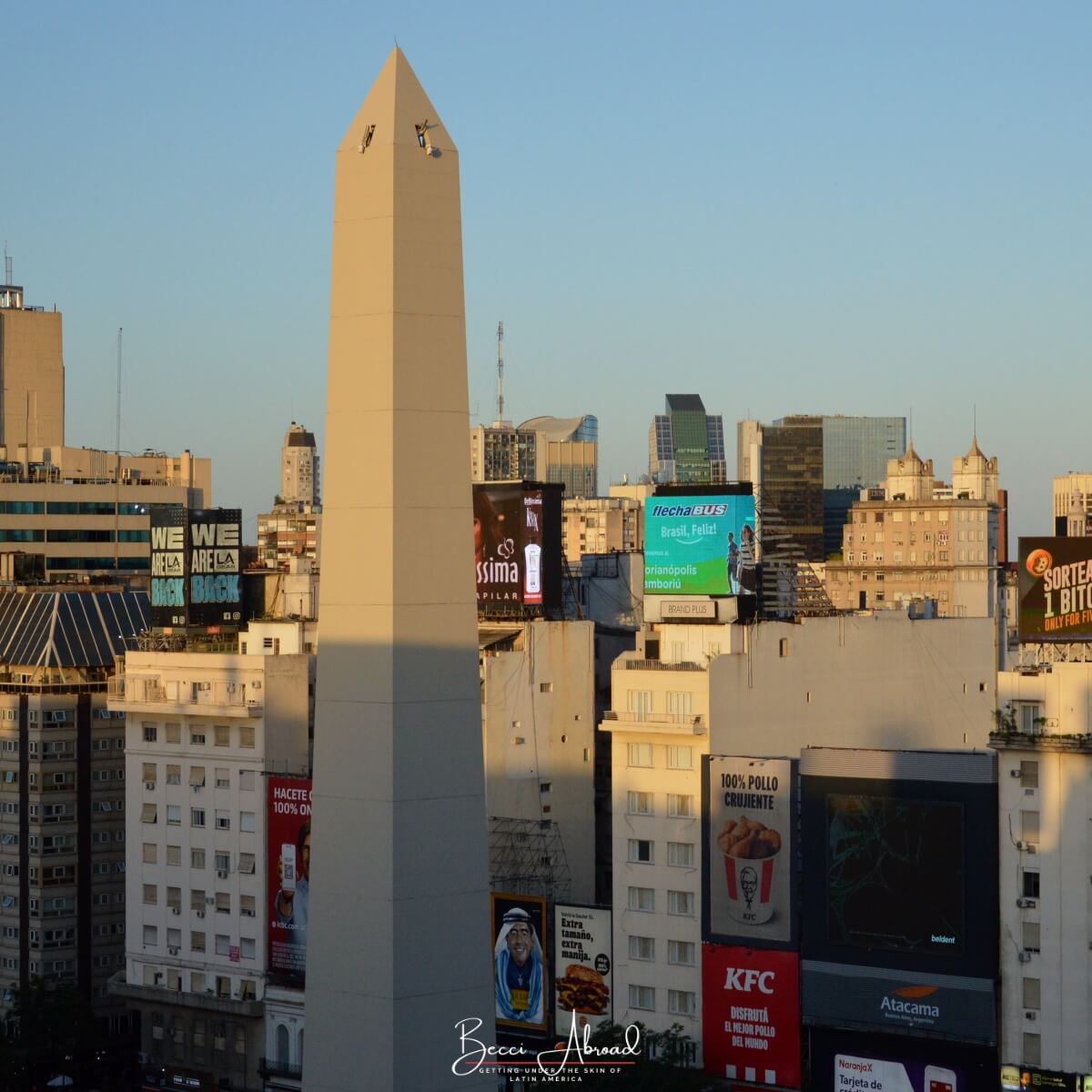

#9 The Colón Theater
The Colón Theater, or Teatro Colón in Spanish, is Buenos Aires’ most famous theater and opera. It is also considered to be one of the best theaters in South America.
The Colón Theater was inaugurated in 1908, and an example of some of the amazing architecture in Buenos Aires.
You can visit the Colón Theater through a guided tour of the Colon Theater. You can also see if you can catch a cheap ticket for a play in the upcoming events at Teatro Colón.
Bonus Sight 7: Behind the Colón Theater, you have a lovely little park with a gigantic and impressive building. That’s the home of one part of the Argentine courts, Tribunales. It is worth making a stop-over.




#10 The Barolo Palace
The Barolo Palace, or Palacio Barolo in Spanish, is one of the most iconic examples of architecture in Buenos Aires. The construction of the incredible palace began in 1919 and it was inaugurated in 1923.
The building was designed by Italian architect, Mario Palanti, who was inspired by Dante’s Divine Comedy for the design of the building. Until the 1930s, it was the tallest building in both Buenos Aires and all of South America.
You can sign up for this city tour including a visit to the Barolo Palace to learn more about this fascinating building.
From the top of the Barolo Palace, you have an amazing view of Buenos Aires. Read more about the best viewpoints in Buenos Aires!

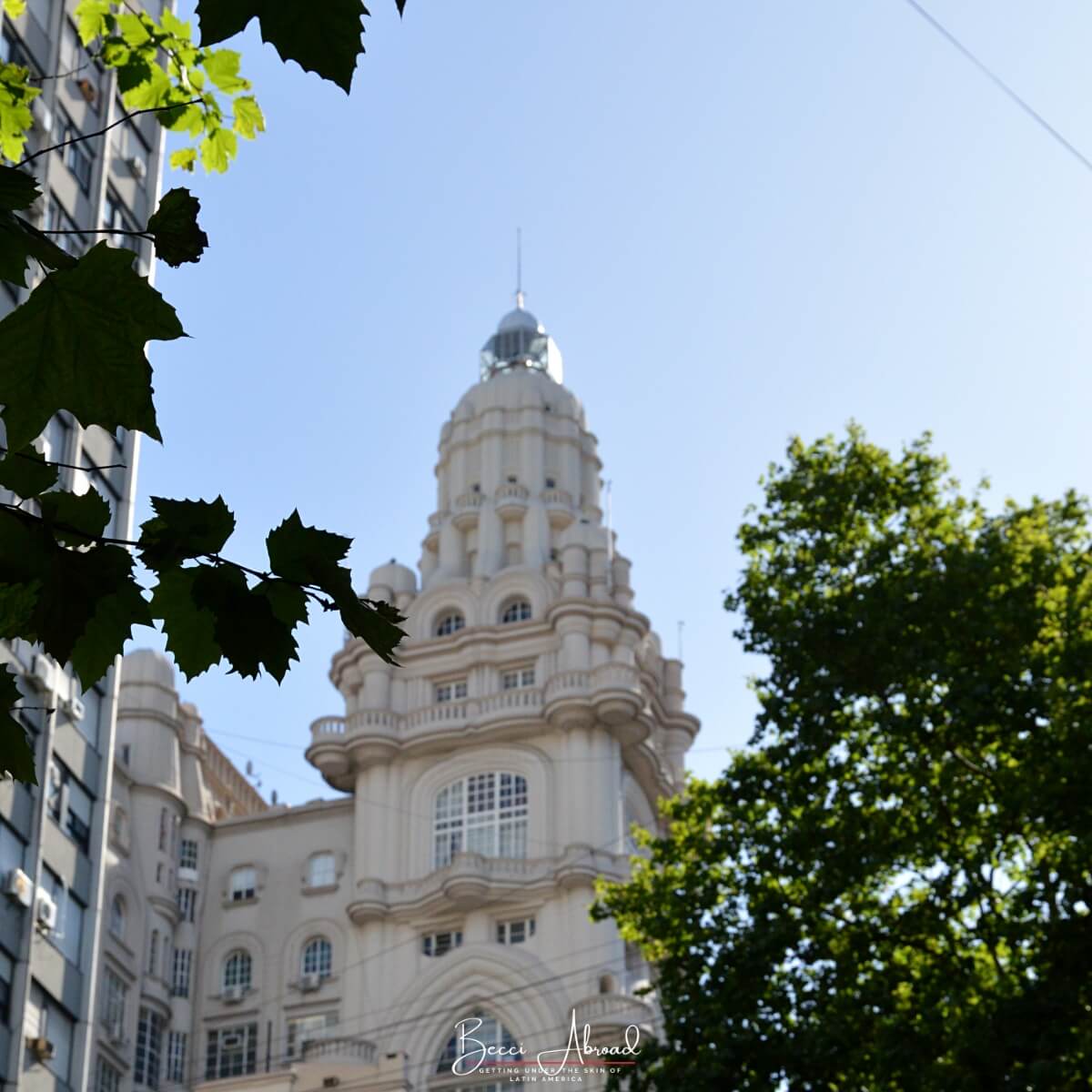

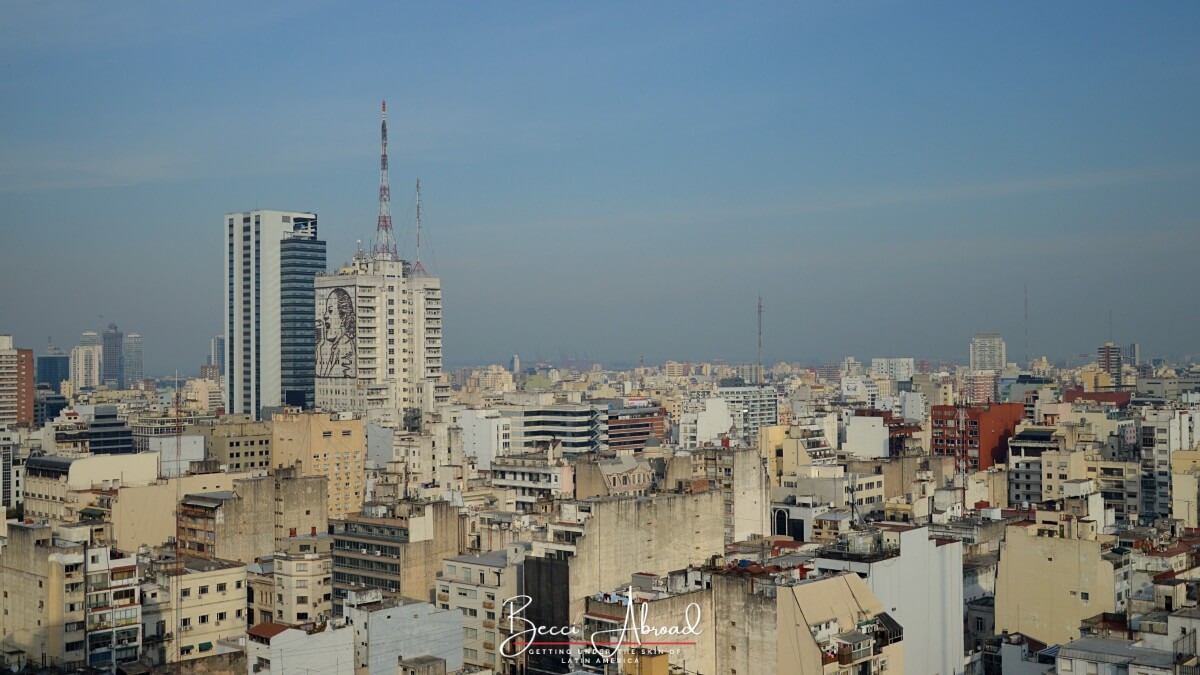
#11 The National Congress of Argentina
The National Congress of Argentina, or in Spanish Congreso de la Nación Argentina, is the legislative branch of the Argentine government. The building houses the branch’s two chambers; the Senate and the Chamber of Deputies.
This neoclassic palace took more than 50 years to build. The construction started in 1898 and the building was inaugurated in 1906. But the construction continued for many years after that.
The walk down Avenida de Mayo from the Pink House to the Congress takes approximately 30 minutes. But, of course, it depends on how many stops and photos you take on your way.
On Monday through Friday at 1 pm the senate offers free guided tours in English. Read more about the free tours of the Congress.
Bonus Sight 8: Around the square by the Congress building, you can see many beautiful old buildings. One of the most notable ones is La Confitería del Molino, an impressive Art Nouveau building from the early 1900s. Read more about Buenos Aires’ remarkable architecture.
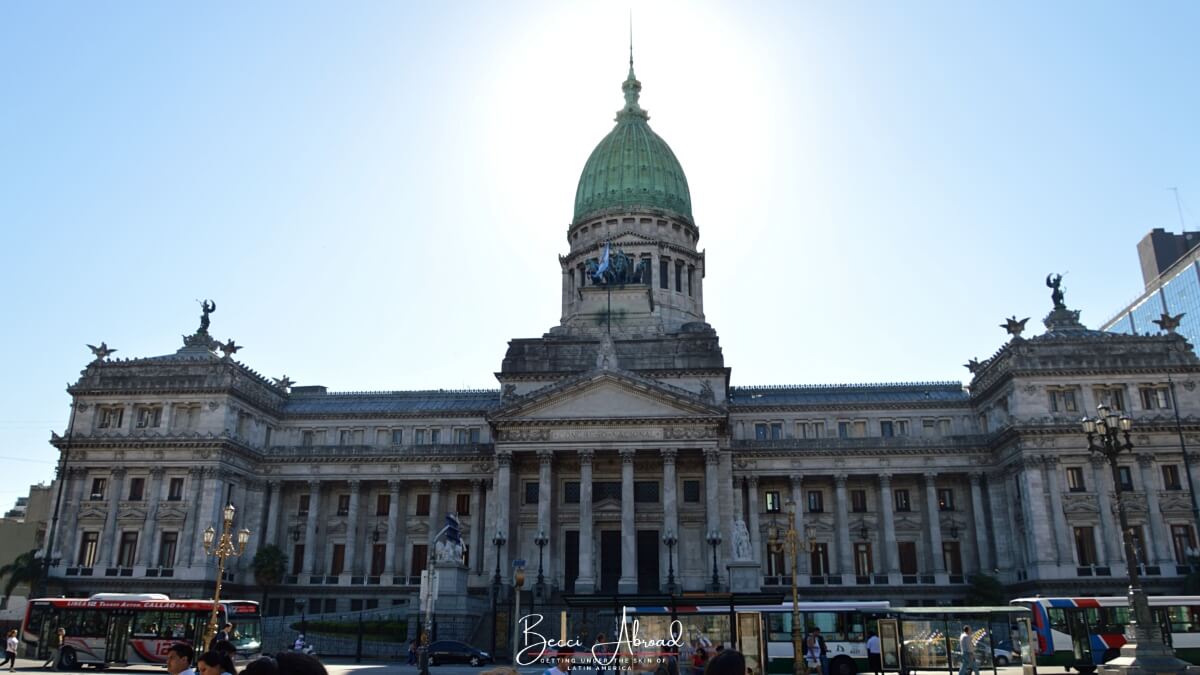


Day 2: Recoleta, San Telmo & La Boca
Get your second day started with a spooky experience at the world-famous Recoleta Cemetery. Then make your way through the neighborhoods of Recoleta, Retiro, San Telmo, and the famous La Boca.
To get around you can either use public transportation or jump in a cab or Uber.
#12 The Recoleta Cemetery
The Recoleta Cemetery, or Cementerio de Recoleta in Spanish is one of the most popular tourist attractions in Buenos Aires.
The cemetery feels like a little village created with tombs and mausoleums instead of houses. It occupies around 5,5 ha of land and houses more than 4,600 graves. The graves are all placed in an interconnected network of isles and pathways. And it is incredibly easy to get lost!
The Recoleta Cemetery was built in 1822. It houses some of Argentina’s most prominent historical personalities such as past presidents, Nobel Prize winners, heroes from the Argentine independence fights, and many more.
There is one grave that everybody is looking for: the grave of Evita Perón!
Argentina’s (in)famous former First Lady is also buried at Recoleta Cemetery. However, it is not one of the most impressive graves in the cemetery. Evita Perón’s grave is small, hidden a bit away, and easy to miss.
The entrance to the Recoleta Cemetery can be purchased online here or at the entrance.
It is highly recommended to sign up for one of the many available tours of the Recoleta cemetery. This way you can learn about its many interesting stories.

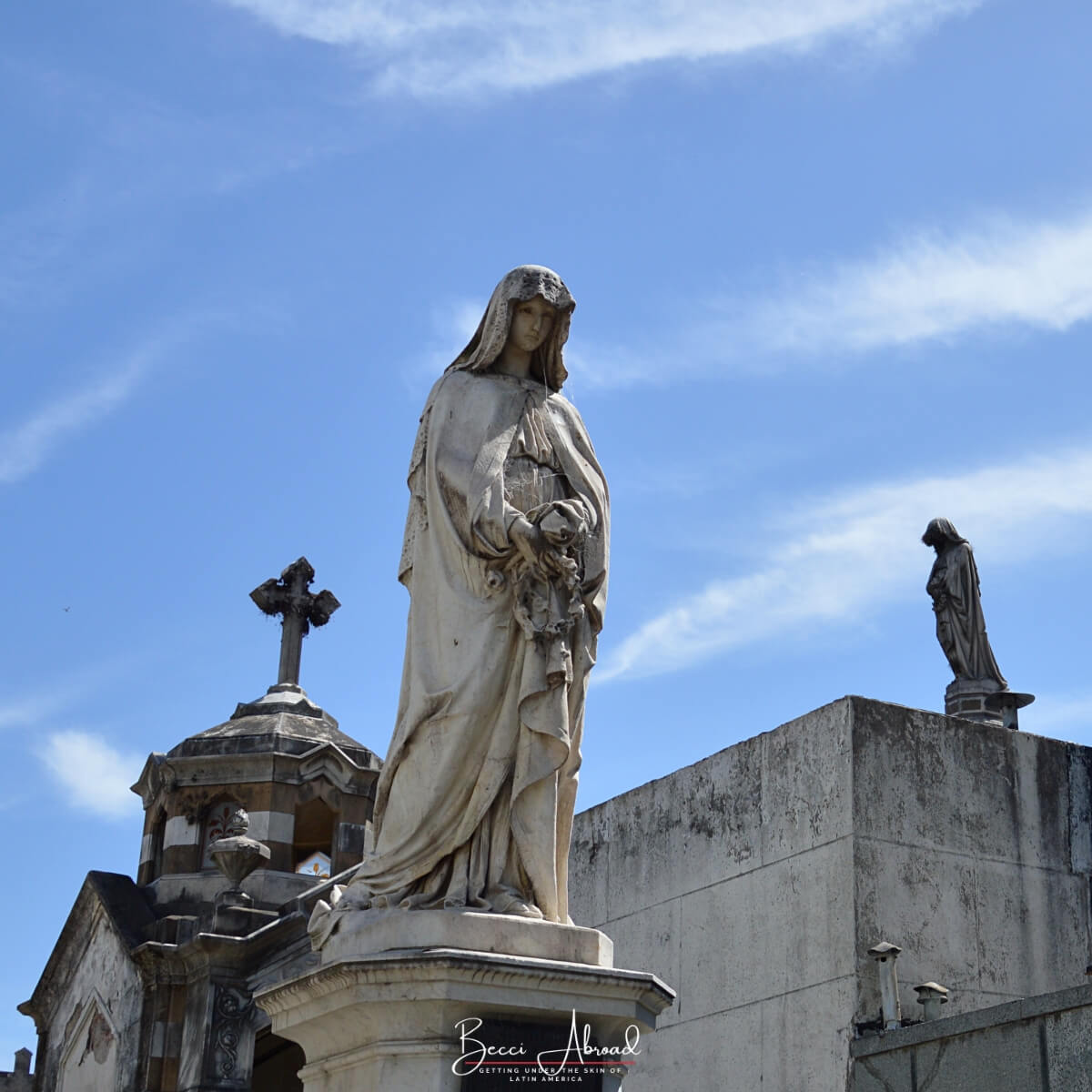


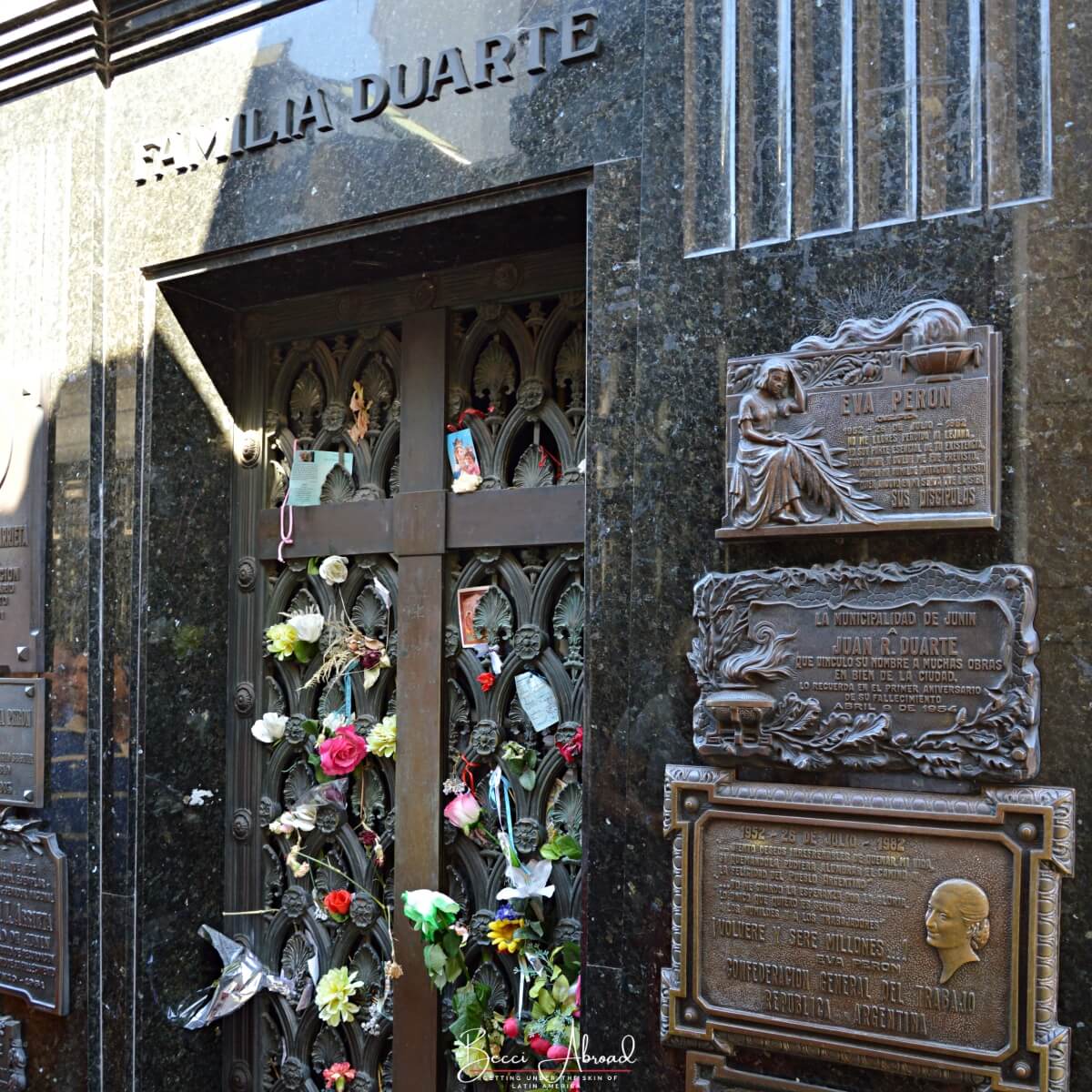
#13 Floralis Genérica
Floralis Generica is a gigantic aluminum flower located in Recoleta, close to the Recoleta Cemetery. It has become an important modern landmark of the city. It is located inside Parque de las Naciones Unidas, translated as The Park of the United Nations.
The impressive sculpture was designed by the Argentine architect Eduardo Catalano in 2002. The sculpture is supposed to open and close according to the time of the day. However, this function has, unfortunately, been broken for years.
This is properly my favorite landmark in Buenos Aires. The entrance to the park is free. If you are looking for more budget-friendly activities, check out these 30 free things to do in Buenos Aires.
Explore the Floralis Genérica and many other amazing landmarks with a top-rated private tour of Buenos Aires with a local guide.
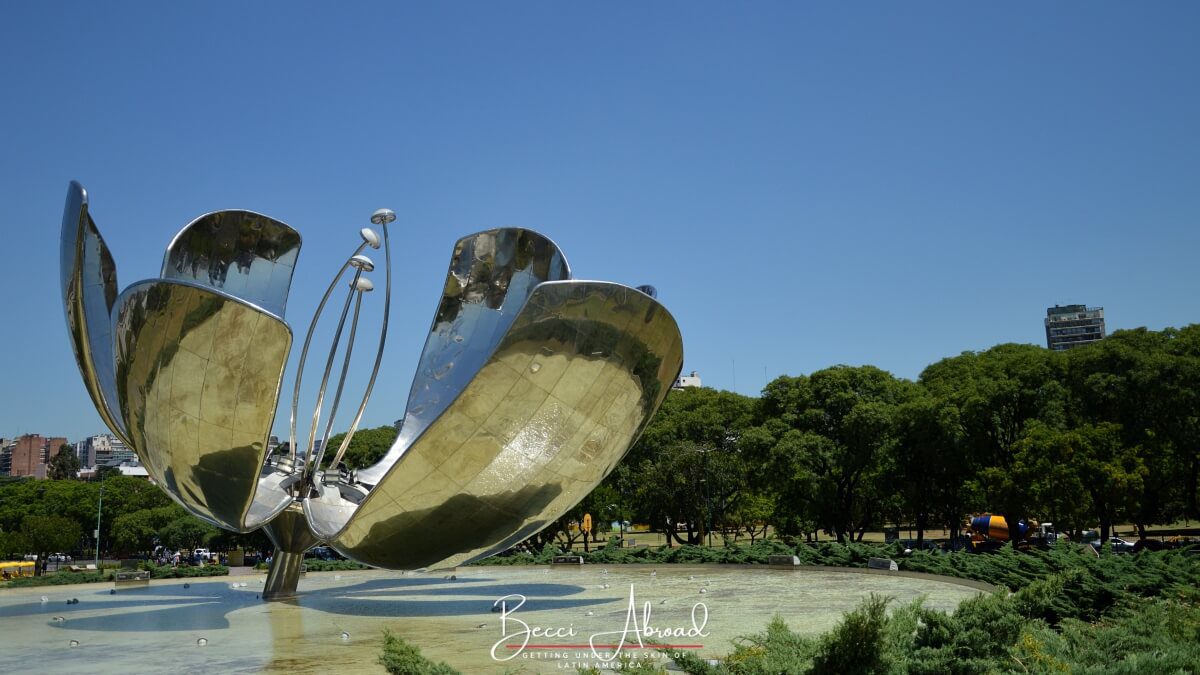
#14 Museum of Latin American Art in Buenos Aires (MALBA)
The Museum of Latin America Art in Buenos Aires, or Museo de Arte Latinoamericano de Buenos Aires (MALBA) is a must if you are into art. The museum is considered one of the best art museums for modern and contemporary Latin American art worldwide.
The museum was opened in 2001 and always has some interesting exhibitions about Latin American art. Read more about the MALBA.

#15 The English Tower
The English Tower, also known as Torre de los Ingleses and Torre Monumental. It is a beautiful clock tower gifted by the British Community to the City of Buenos Aires in 1916.
The English Tower is also a great viewpoint to see Buenos Aires from above.
The tower is located in the Retiro neighborhood of Buenos Aires by the Retiro train station.
From MALBA, jump on a local bus and head to Retiro to visit the English Tower.
Bonus Sight 9: In front of the clock tower, you have the beautiful historical park, Plaza San Martin. Walk up the big stairs of the park for a beautiful view over Retiro and the English Tower.
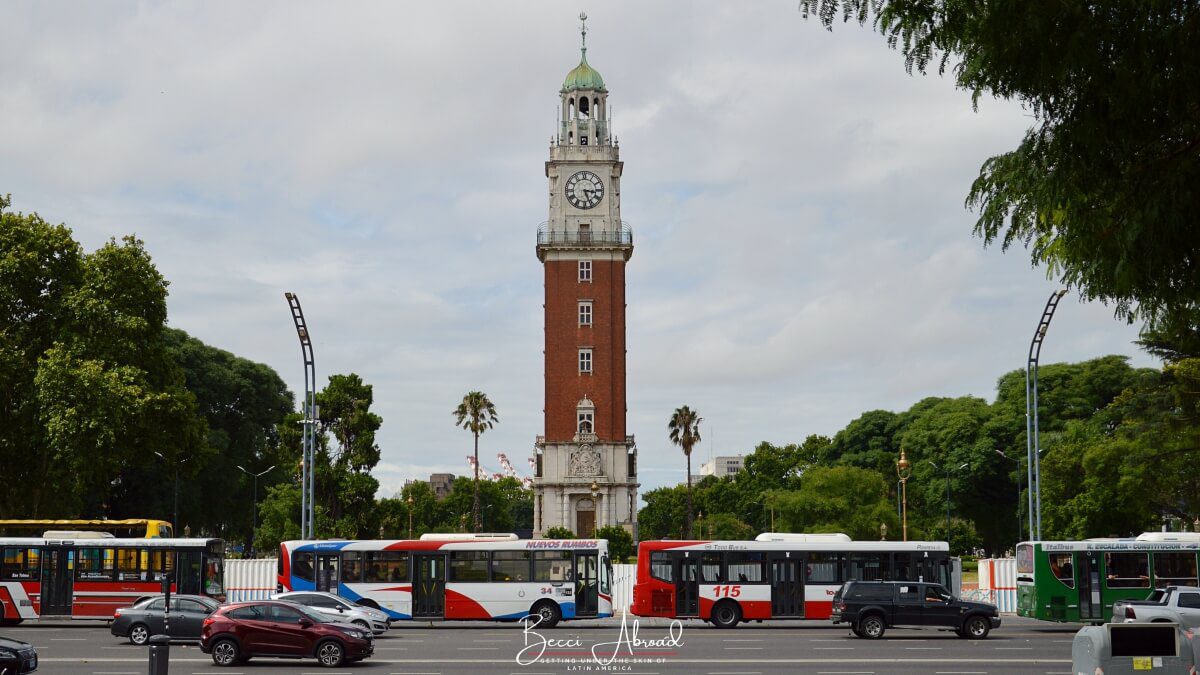


#16 San Telmo & San Telmo Sunday Market
San Telmo is a historic neighborhood in Buenos Aires. To wander around the cobbled stone street and admire the historic houses is like taking a step back in time.
Every Sunday, the street Defensa in San Telmo turns into a huge street market. The market is called Feria de San Telmo in Spanish. Here you can find all kinds of handcraft and souvenirs.
This is the perfect spot to find souvenirs for your loved ones at home. Or maybe just as a memory from your trip. Read more about what to do in San Telmo.
The beginning of San Telmo is just by the Pink House. You can either walk from the English Tower, take a public bus or a taxi to the May Square.
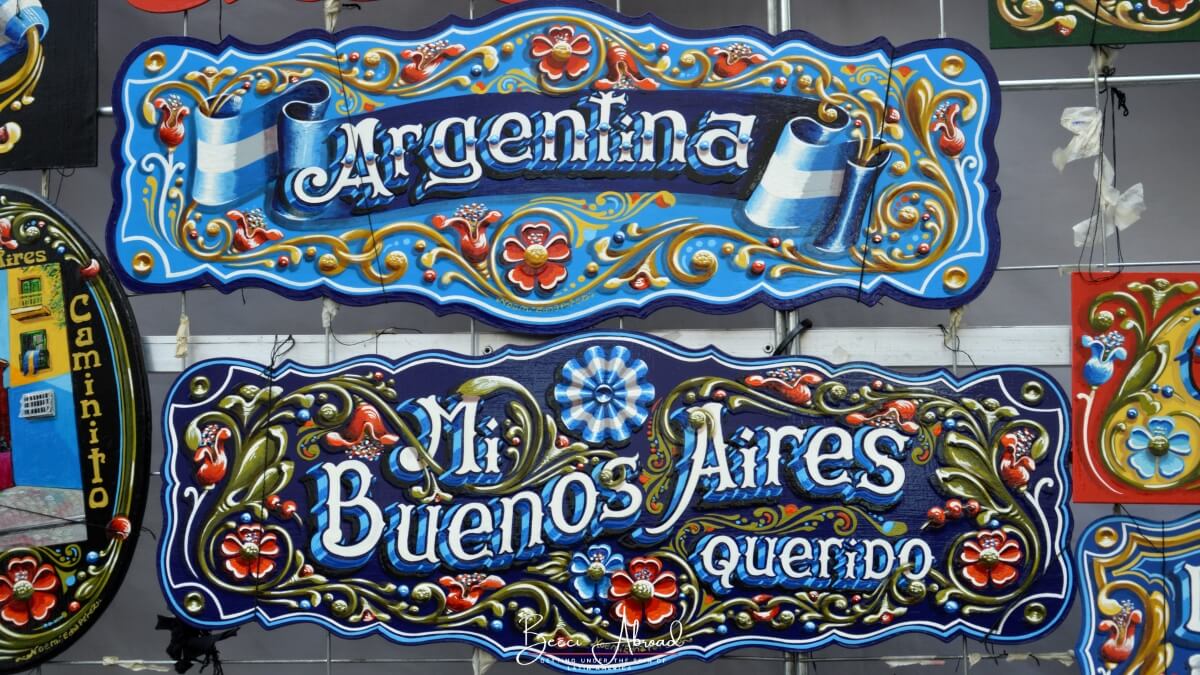


#17 La Boca & El Caminito
La Boca is one of the most well-known areas in Buenos Aires by foreign visitors. The area’s colorful houses are on almost every travel catalog you see of Buenos Aires.
La Boca is an old immigrant neighborhood. Due to its proximity to the harbor, many of the immigrants who flew to Argentina in the 1880s and the early 1900s settled here.
Most of these people didn’t have much. So, they painted their houses with the colors left from the maintenance of the ships at the port.
The history of the area is fascinating and tells an important story of the development of Buenos Aires. But today La Boca and the famous El Caminito – a colorful corner house – are more touristy than historical.
From San Telmo or Plaza de Mayo, you can jump on a bus or in a taxi and head to La Boca. Or you can try out this bike city tour which also includes La Boca and El Caminito.
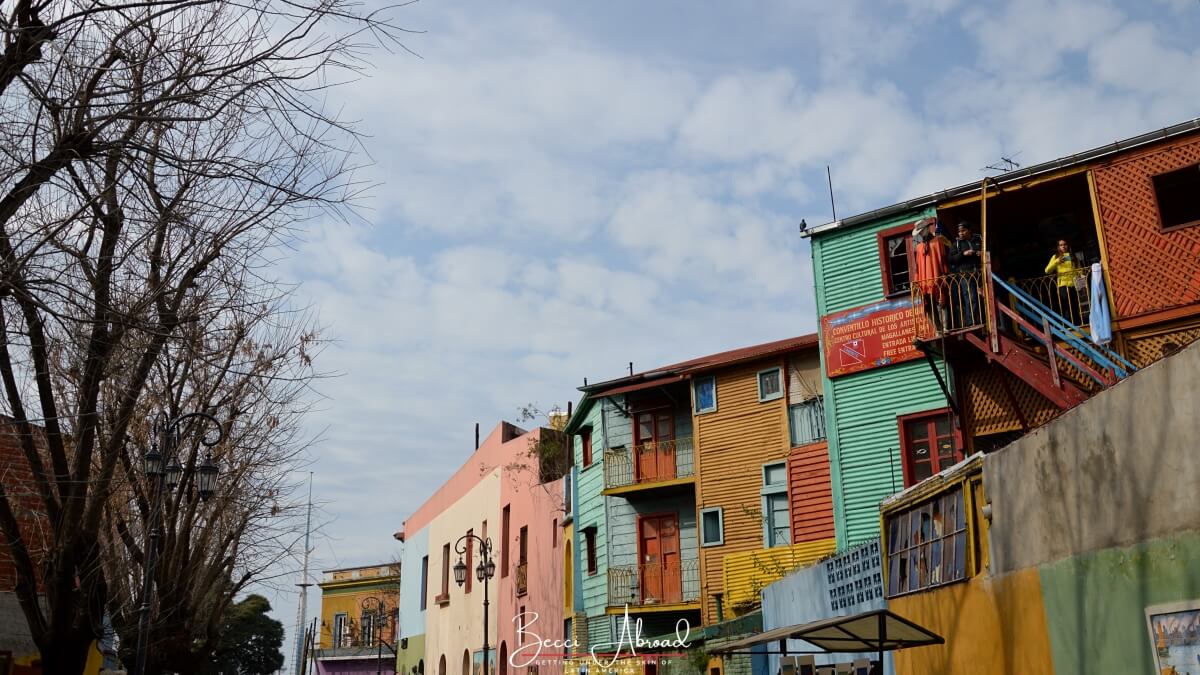

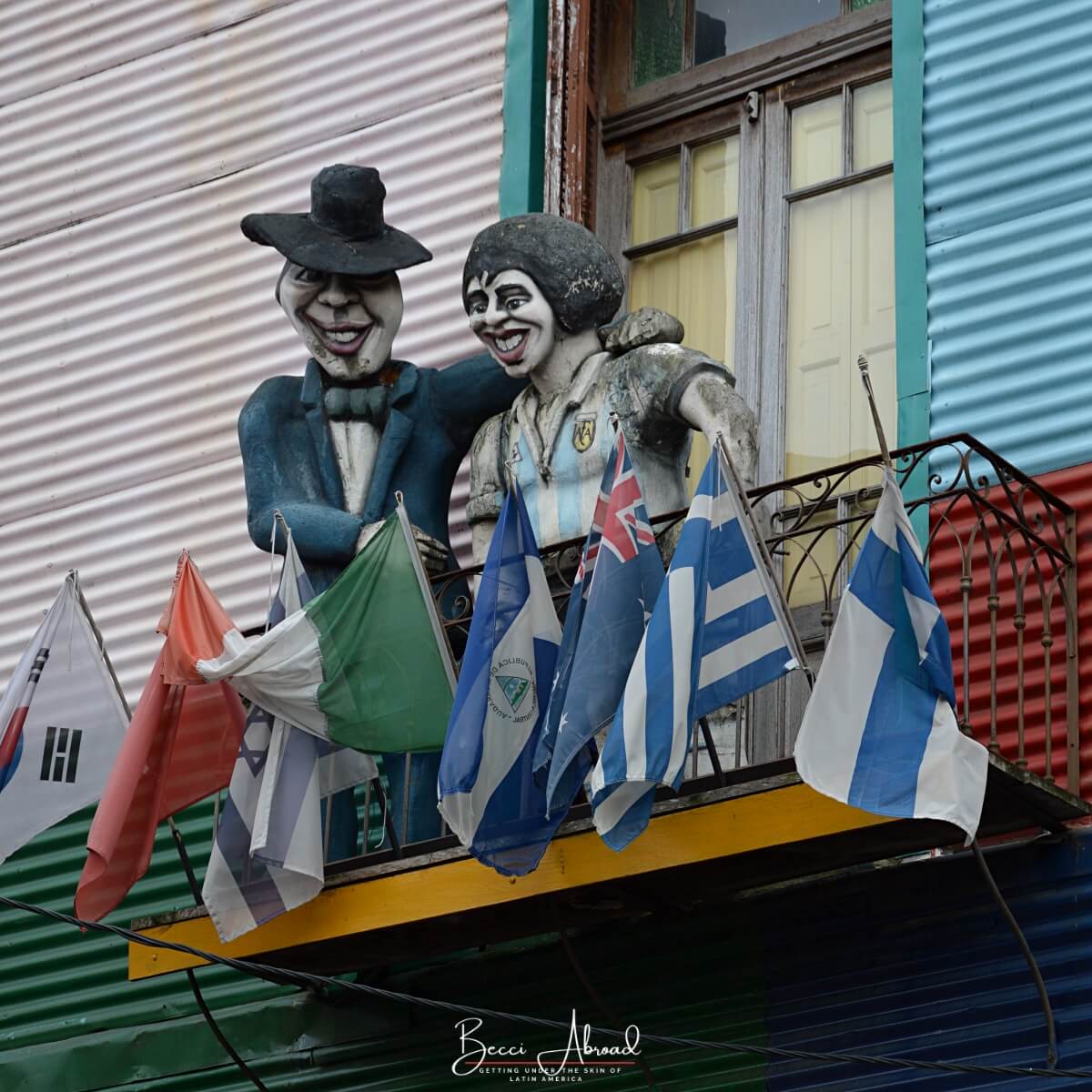
Day 3: Palermo
Spend your third day enjoying some green areas and Buenos Aires’ foodie heaven: Palermo. But first, let’s explore some more of the amazing architecture in Buenos Aires.
#18 The Ateneo Grand Splendid Bookshop
The Ateneo Grand Splendid is a bookshop like you have never seen before! The massive building on Avenida Santa Fe was built to be a theater in the 1920s.
After having been closed down several times, in the early 2000s, it was turned into a bookshop. However, the features and decorations from the time when it was a theater were kept. The result is absolutely impressive! Read more about the Ateneo Grand Splendid Bookshop.
Join this top-rated private tour from Viator to learn more about the Ateneo Grand Splendid and its secrets!
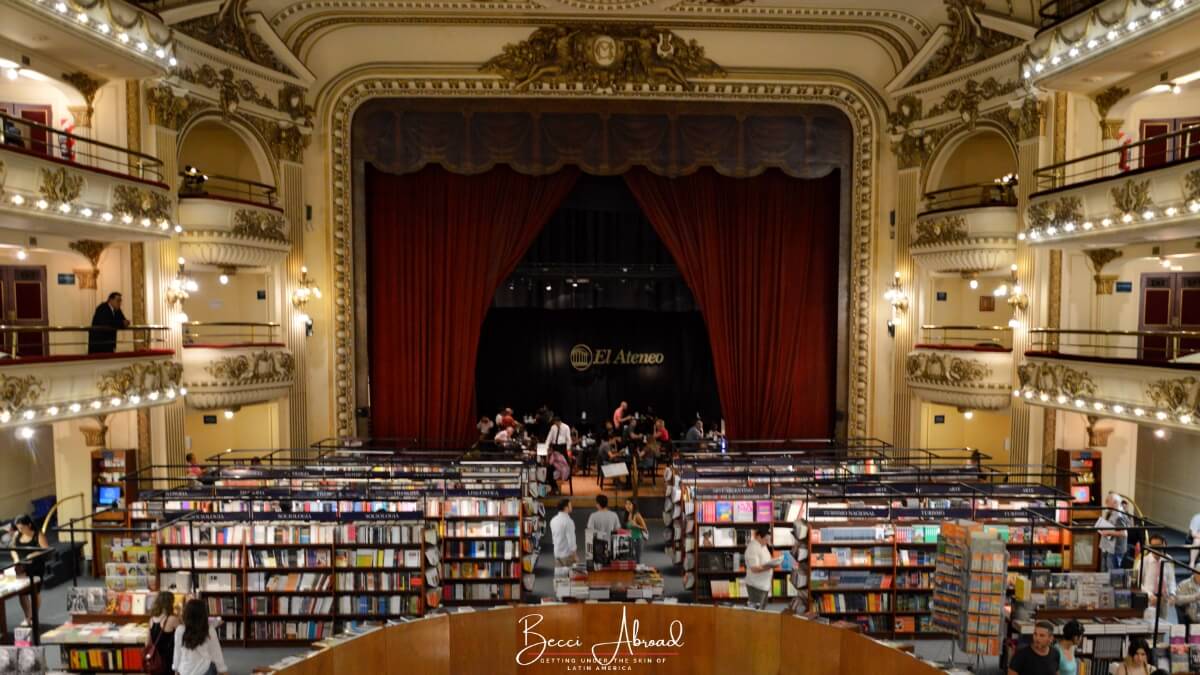
#19 Buenos Aires Botanic Garden
Buenos Aires Botanic Garden, or jardín botánicó Carlos Thays is a beautiful green spot in Buenos Aires.
The garden features many different local species, greenhouses, and sculptures on its seven hectares of land. It’s a great spot for slowing down after long days of sightseeing.
From Ateneo Grand Splendid, hit down the Avenida Santa Fe for about 1.8 miles (3 km) until you reach the entrance to the Botanic Garden. You can also jump on a local bus or jump in a cab to get to the garden.
Bonus Sight 10: Close to the Botanic Garden, you will find another famous park in Buenos Aires: the Palermo Forests and its rose garden, Paseo El Rosendahl.

#20 Plaza Serrano & Street Art at Pasaje Russel
Palermo is the biggest neighborhood in Buenos Aires with many subsections with different vibes.
In Palermo, you will find many different bars, restaurants, and trendy shops. Experience Palermo through Argentine food with a foodie tour. Palermo is also popular among international exchange students for its lively nightlife.
A popular place to visit in Palermo is the area around the square Plaza Serrano. On weekends, there is a local market on Plaza Serrano selling clothes and accessories, especially for women. A stone’s throw from Plaza Serrano, you will find Pasaje Russel, a side street covered in street art. It is a great spot to explore some of the city’s street art scene.
However, there are so many other amazing pieces of street art around the city that you should consider checking out if you have the time.
Read more about street art in Buenos Aires.
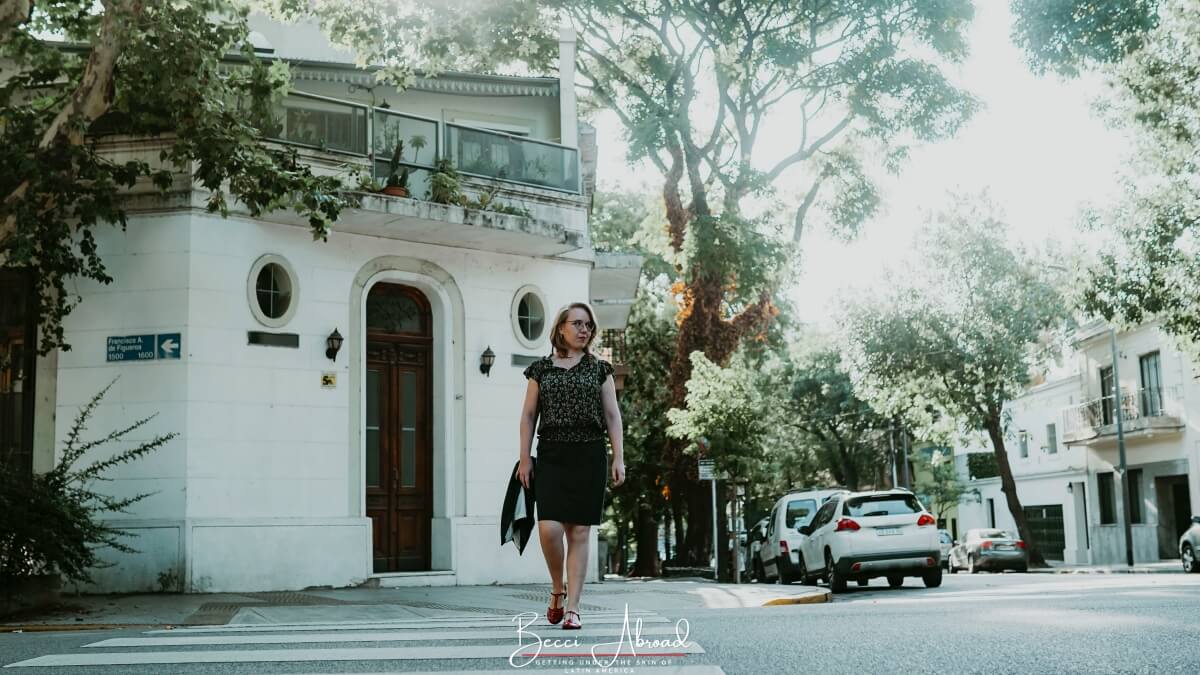

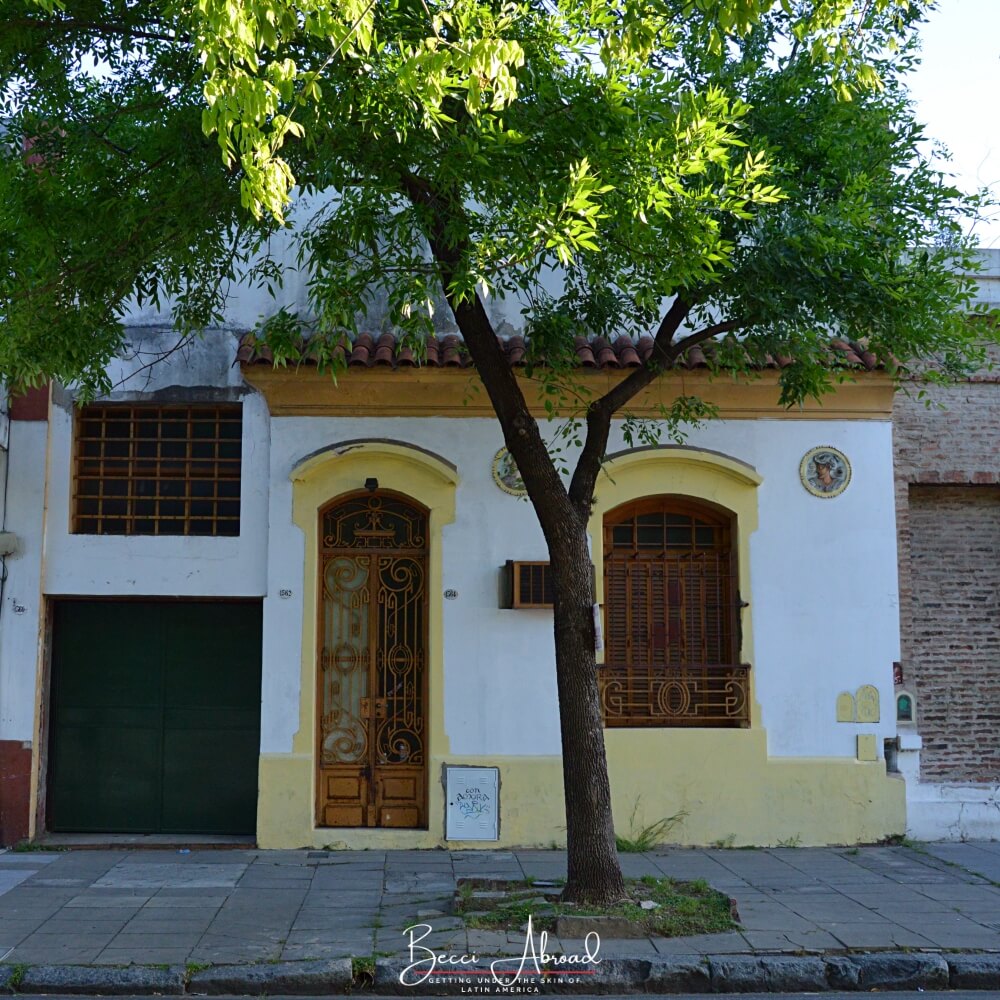
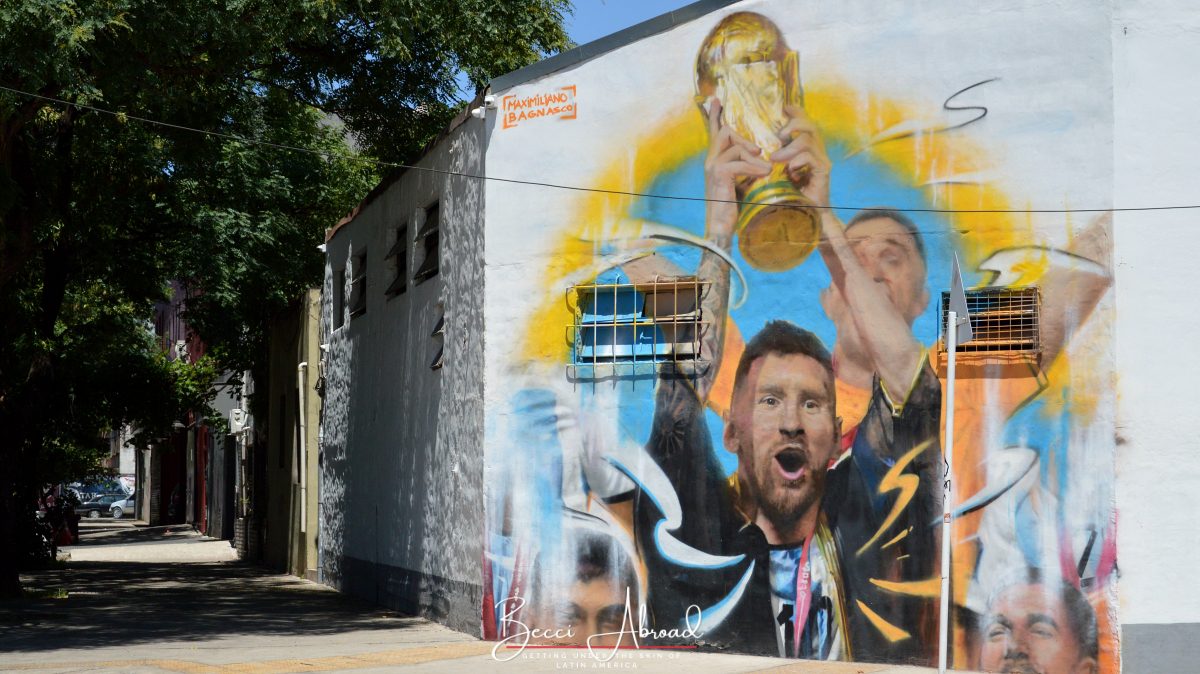
Bonus trip: Day Trip to the Tigre Delta
If you have time in your Buenos Aires itinerary, try a day away from the city!
The Tigre Delta is a huge delta area located just north of Buenos Aires towards the border with Uruguay. It is the perfect destination for a relaxing boat ride.
Along the riverside, people have built their houses, and boats are the residents preferred means of transportation. Check out the different options for day trips or half-day tours to Tigre Delta.

Want to Spend Longer Time in Buenos Aires?
You can easily spend 4 to 5 days in Buenos Aires to explore more of Argentina’s beautiful capital city!
There are plenty of hidden gems, beautiful buildings, viewpoints to visit, and asado to eat in Buenos Aires. Or you can explore some of the many day trip options from Buenos Aires.
Share the love and pin the post!









